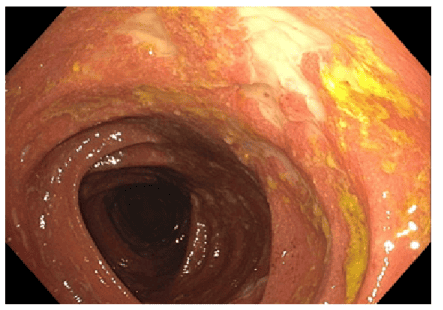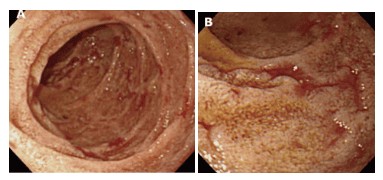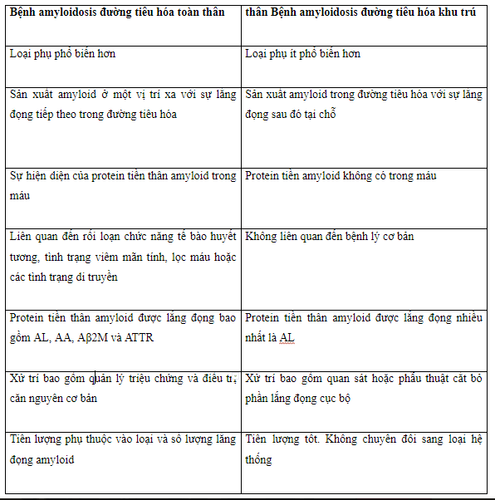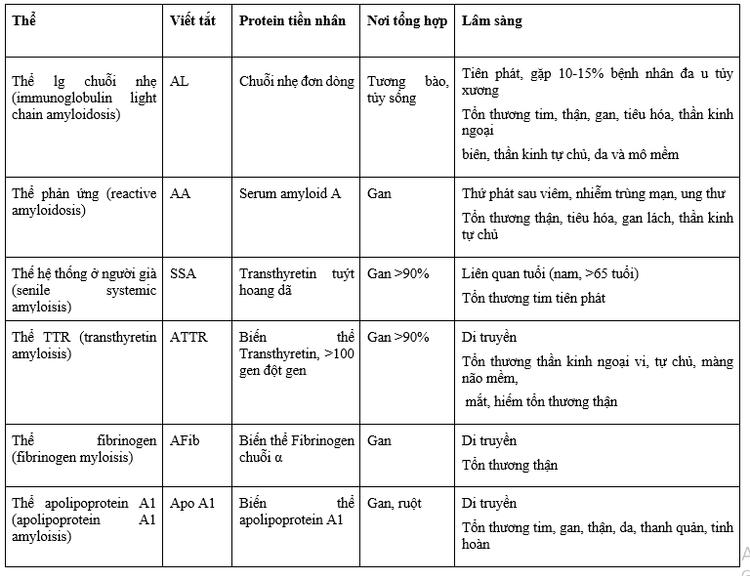This is an automatically translated article.
Posted by Master, Doctor Mai Vien Phuong - Department of Examination & Internal Medicine - Vinmec Central Park International General HospitalIn 1853, Rudolf Virchow first used the term "amyloid" to describe deposits in a description that closely resembled starch after they were dyed with iodine and sulfuric acid. Amyloidosis comprises a heterogeneous group of disorders characterized by extracellular deposition of filaments, which aggregate into a three-dimensional ß-lamina site (plates arranged in anti-pattern tracks) in models , disrupting the structure and normal function of tissues.
According to the Center for Genetic Information and Rare Diseases (GARD) of the National Institutes of Health (NIH), amyloidosis is a rare disease. It is known to have a flat spectrum and possible clinical presentation, thus making an accurate epidemiological assessment extremely difficult. According to the data available from the NIH, light-chain (light-chain) amyloidosis has an incidence of 1 case per 100,000 person-years in the West.
1. Epidemiology
According to GARD, amyloidosis is a rare physical disease. It is known to have a broad spectrum of possible etiologies and clinical manifestations, thus making precise epidemiological assessment extremely difficult. Furthermore, regional variations in the environment, for example, rates of local infections and autoimmune diseases lead to chronic inflammation, and genetic factors such as polymorphisms in genes encoding amyloid precursors also may contribute significantly to the development of the disease. Studies, although limited, have been performed to evaluate the epidemic curriculum of this disease in the United States and worldwide. According to the latest statistics available from the NIH, light-chain amyloidosis has an incidence of 1 case per 100,000 person-years in Western countries and in the United States between 1275 and 3200 new cases are reported annually.
Systemic amyloidosis is more common than focal amyloidosis and the annual incidence of primary systemic amyloidosis (AL) is 78% when primary systemic amyloidosis (AA) uses only 6% of the number of cases each year in the United States. Familial transthyretin-associated amyloidosis, which is thought to be less common and with an unclear incidence, uses approximately 10% to 20% of cases managed in tertiary hospitals in the United States.
Outside the United States, similar trends in incidence have been observed. Similarly, Hemminki et al., estimated the incidence of amyloidosis to be 8 patients per million person-years in Sweden, of which 3 cases per million person-years were reported as light-chain amyloidosis and 2 cases in humans five is serum amyloidosis . Typically, amyloidosis presents earlier in life and usually affects a larger demographic (median age for the AL subtype is 63 years). Questioning rates and higher morbidity have been reported in men than in women. In the United States, the literature also reports a significant increase in amyloidosis-related mortality from 1.77 to 3.96 per million people between 1979 and 2015, with the highest rates reported. observed in people of African descent. Gastrointestinal involvement can be seen in both focal (intestinal only) and systemic (commonly as AL subtype) amyloidosis.

2. What is gastrointestinal amyloidosis?
Gastrointestinal amyloidosis is defined as the presence of gastrointestinal signs and symptoms along with direct generative device verification of the disease. It is commonly seen in elderly men. Yen et al performed a single-center resuscitation study from 2008 to 2017 of 583 patients with amyloidosis and observed that only 96 (16.8%) patients had signs and gastrointestinal tract symptoms. . Of these 96 patients, 82 underwent gastroscopy (upper gastrointestinal endoscopy) or colonoscopy with a birthing device, and it was reported that only 37 (45%) of the patients were delivered. demonstrated gastrointestinal amyloidosis, while 45 (55%) patients did not have GI amyloidosis on biopsies.
Similarly, another resuscitation study evaluating 2337 patients over a 13-year period using the Boston University Study database reported a demonstrated birth of GI Amyloidosis in 76 (3) ,3%) patients. Furthermore, on upper gastrointestinal endoscopy or colonoscopy, the site for the highest results from bioassays was found to be the duodenum, followed by the stomach, colon, and rectum, and perform management. Therefore, it can be concluded that demonstrating gastrointestinal amyloidosis with the work of verifying device biopsies directly from the GI tract is a rare phenomenon. There is also a substantial amount of gastrointestinal evidence of amyloidosis with most data available from primary, single convalescent, or single case reports. The authors therefore support the necessary power of additional multicentre monetary studies to capture the global impact of gastrointestinal amyloidosis and its weight on health functioning systems. .

2. Classification - Amyloidosis can be classified based on clinical or biochemical nature of each precursor protein.
Clinical classification
Amyloidosis can be broken down into two subtypes based on the site of amyloidogenic precursor protein production and its deposition in tissues, including systemic amyloidosis and focal amyloidosis.
Systemic amyloidosis is more common than focal disease, and the annual incidence of primary systemic amyloidosis is 78% while the incidence of secondary systemic amyloidosis is only 6% annually in the United States. In the literature, about 60 amyloidogenic proteins have not been uniformly identified, of which 27 are associated with known disease.
Based on the site of amyloidogenic precursor protein production and its deposition in models, it can be classified into two dependent categories: systemic and focal amyloidosis. Gastrointestinal involvement may be a feature of both subtypes. Gastrointestinal (gastrointestinal) amyloidosis is defined as the presence of gastrointestinal signs and symptoms resembling the direct bioequivalence of the disease.
However, according to the current literature, demonstrating gastrointestinal amyloidosis with bioassay work directly from the gastrointestinal tract may be a rare phenomenon. Therefore, in this review, the authors describe different subtypes of amyloidosis with amyloid-associated precursor protein deposited in models.

Systemic amyloidosis
The most common form of the disease. It is characterized by the production of amyloidogenic precursor proteins at a site distal to the amyloid deposition site. It can be due to acquired conditions such as plasma cell dysfunction or inherited conditions caused by changes in the transthyretin (TTR) gene. Amyliod circulates to different organs in the body causing pathology in many organs and systems. This form is often severe, has a high mortality rate, and has a short survival time, usually no more than 13 months from the onset of the disease.
Primary form: plasma cell disorder, multiple myeloma. Secondary type: inflammation, chronic infection, cancer. Familial form: Familial Mediterranean fever... Focal amyloidosis
It is characterized by the production of amyloidogenic precursor proteins at the same site as its deposition site. It usually involves the respiratory tract, urinary bladder, breast, skin, or gastrointestinal tract. A single-center retrospective analysis by Cowan et al reported that of the 3.3% of patients whose biopsies demonstrated amyloidosis, only 21% had limited gastrointestinal amyloidosis. Therefore, focal amyloidosis is an uncommon entity. Amyloid deposition is limited to a certain organ, most often the skin, possibly in the endocrine organs, the brain.
Skin: primary and secondary Endocrine: thyroid cancer, pancreas, diabetes... Brain: Alzheimer's disease Difference between systemic and focal gastrointestinal amyloidosis.

AL: Monoline light string; AA: Serum amyloid A; Aβ2M: β2-microglobulin amyloid; ATTR: Transthyretin-associated amyloidosis in the family; Digestive tract : Digestion.
Classification based on the nature of prokaryotic proteins According to the nature of prokaryotic proteins: there are more than 25 types of prokaryotic proteins of different amyloids. Below is a list of some common diseases.
Some forms of amyloidosis disappear

Conclusion
Amyloidosis is characterized by extracellular deposition of autologous fibrous proteins that assemble into three-dimensional ß pleated sheets arranged in an anti-parallel fashion. Based on the site of production of amyloidogenic precursor protein and its deposition in tissues, it can be divided into two distinct subtypes, systemic and local amyloidosis. Gastrointestinal involvement (gastrointestinal amyloidosis) can be seen with both subtypes. Patients with gastrointestinal amyloidosis often present with fatigue, dizziness, anorexia, weight loss, gastrointestinal bleeding, malabsorption, protein-losing enteropathy, or gastrointestinal disturbances. chronic chemistry.
Please dial HOTLINE for more information or register for an appointment HERE. Download MyVinmec app to make appointments faster and to manage your bookings easily.













